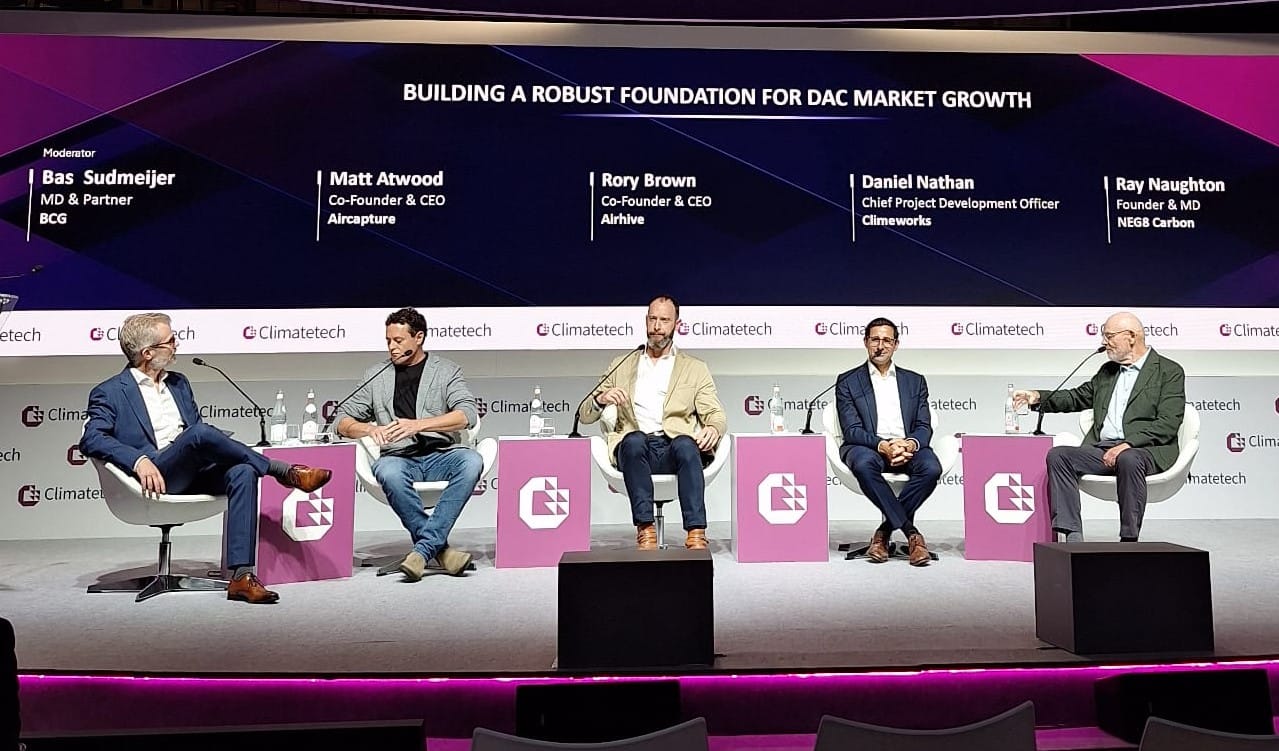Gastech 2025: Building a Robust Foundation for Direct Air Capture Market Growth
10 September 2025
Direct Air Capture (DAC) technology was the focus of attention at the Climatech Theatre during Gastech 2025 in Milan, where a panel of leading DAC innovators debated how to build a foundation for market growth.
With 27 plants already operating worldwide and 130 more in development, DAC is attracting investment. Yet the sector still faces some hurdles: costs, demand, technology readiness, and the challenge of finding low-carbon energy and storage solutions at scale.
Moderated by Bas Sudmeijer of BCG, the panel featured Ray Naughton (NEG8 Carbon), Matt Atwood (Aircapture), Rory Brown (Airhive), and Daniel Nathan (Climeworks).
Together, the panel explored the current reality and what it will take to bring DAC from early pilots to gigaton-scale removal.

The panelists looked into:
Where we are Today with DAC
Scaling Supply Without Spiraling Costs
Early-stage companies stress the need to expand modular units quickly, while keeping production costs under control. Looking at the whole picture, it’s not just about the chemistry but execution, logistics and reliable infrastructure matter just as much.
Technology Bottlenecks
Reducing DAC’s energy demand and increasing sorbent efficiency will determine how well this technology pushes through to large scale deployment.
Utilisation Limits
What you do with the CO₂ you capture is as important as capturing it in the first place. At present, CO₂ utilisation has limits: it can support early revenues, but permanent storage must become the ultimate destination for climate-relevant removals.
What it will Take to Grow DAC
Government Funding for DAC
The panelists agreed on the urgent need for governments to step up and deliver more government-backed R&D for DAC technology, particularly for sorbent innovation. On a deeper note, the industry grapples with what’s realistic in terms of shared innovation versus remaining competitive.
Investment in DAC
Financiers may misunderstand DAC risks, and going a step further, the speakers unpacked how the sector could make itself more investable. The DAC industry could demonstrate predictable revenue streams, whether through utilisation projects, government contracts, compliance markets, or corporate buyers willing to commit to long-term removals. Clearer carbon accounting standards would also help investors assess projects with greater confidence.
The Elephant in the Room: Financing DAC
Perhaps the toughest barrier is project finance. DAC won’t scale until it is bankable infrastructure rather than niche tech, and policy tools such as long-term contracts and carbon markets will be important to give lenders the certainty they need.
CO₂ Storage and DAC Locations
Meanwhile, storage capacity and site availability remain fundamental to any successful DAC project. The ‘perfect DAC site’ depends on storage and ‘green’ energy and the question is: how rare/abundant are these sites? However, the nature of DAC technology means it can be placed in diverse geographies and at the site of CO₂ sequestration. Nevertheless, the storage factor can sometimes be a holdup with permitting delays and infrastructure development slowing progress. In the end, building out CO₂ storage hubs must go hand in hand with scaling DAC.
The Road Ahead for Direct Air Capture
Currently, most DAC technologies have operating costs above the $200 per tonne CO₂ captured, but the sector is surging forward as technology advances, projects scale and supply chains strengthen, bringing DAC ever closer to the $100 per tonne goal.
The panel’s message is clear: DAC can become a global pillar of decarbonisation, but only if policy, finance, and technology innovation move in step.
About Gastech
Gastech is one of the world’s largest energy exhibitions and conferences, focused on natural gas, LNG, hydrogen, low-carbon solutions, and climateTech, bringing together industry leaders, policymakers, and innovators to discuss the sector’s future. Gastech gathers over 50,000 industry stakeholders from 150 countries, including 1,000 speakers and 1,000 exhibitors from across the energy value chain. The first Gastech conference was held in London in 1972.

